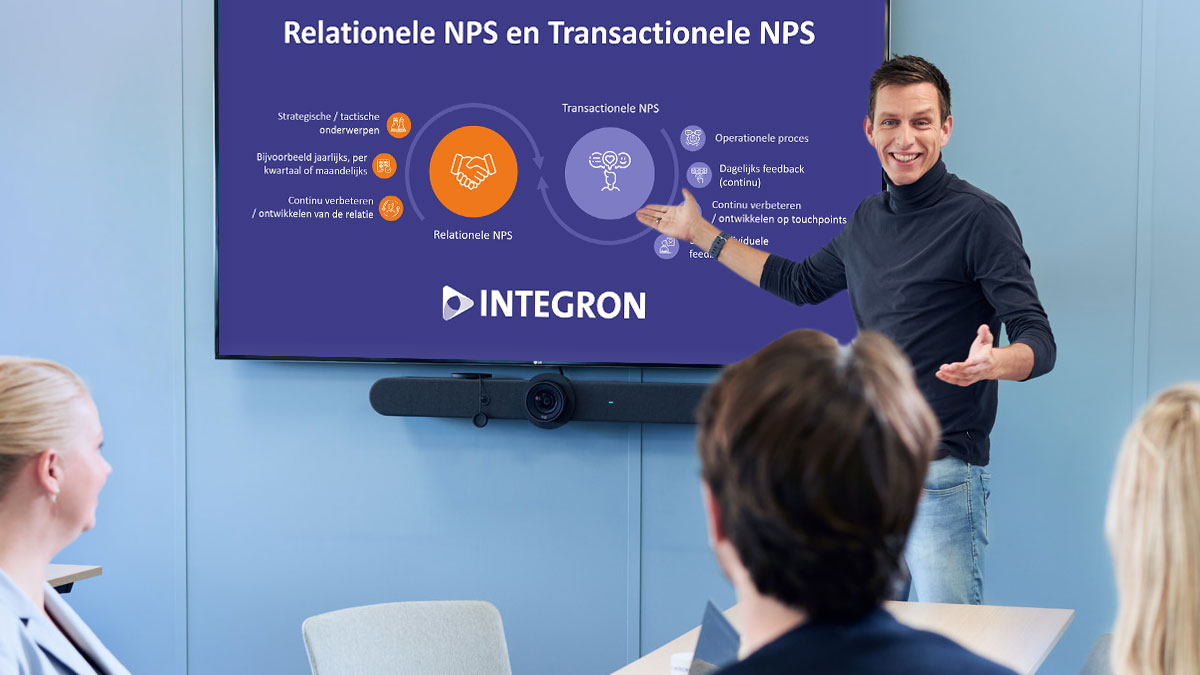Through the NPS, you ask the pressing question: on a scale of 0 to 10, how likely are you to recommend our organization to someone else? Customers who rate 9 or 10 are promoters and actively recommend you. Moreover, they are loyal and more likely to purchase more products or services. A promoter provides future sales that are three times higher than those of customers lower on the NPS ladder. In particular, recommending your brand or organization has a sales and revenue boosting effect. You can measure NPS in several ways; including the relational or transactional way. Now when do you deploy which measurement method? We give the differences and the pros and cons.
What is a relational NPS?
A relational NPS is about how likely a customer is to recommend your company to a colleague or relation. You measure the relational NPS at any time, such as annually, quarterly or monthly. The goal is to understand how enthusiastic customers are about your organization. It also gives a good idea of where your company stands in its relationships with customers. You can use the feedback to improve the relationship.
The relational NPS is usually measured within a broad customer experience survey that consists of strategic and tactical topics, such as image, loyalty, competitiveness and the customer journey on headlines.
Benefits relational NPS measurement
- Nice KPI to gain initial insight into customer experience in broad terms
The relational NPS is a nice and important KPI to get an outline understanding of the customer experience. A high NPS is not the goal in itself, but provides the insight needed to pursue an excellent customer experience. Therein lies an important and beautiful challenge, because it will bring you more enthusiastic customers who will recommend your organization.
- Easy to benchmark
The NPS question is unambiguous and can always be asked and compared in a customer experience study orsurvey , with the baseline measurement being the “benchmark starting point. There is also a benchmark available from Integron “Customer Experience in the Netherlands 2021,” which gives you a good look at where you stand as an organization.
- Opportunity to engage all customers
As mentioned, you can use a relational NPS measurement broadly within a customer satisfaction survey or via a shortsurvey that you send to all your customers at once. Relative to transactional measurement, you can therefore include your entire customer base in the survey at once, which can give a good initial overview. You can deploy thesurvey/survey periodically as desired and measurement needs dictate.
- First step to introduce employees to and work with customer feedback
Relational NPS measurement results provide input for relationship managers, account managers and inside sales to improve relationships with customers based on individual customer feedback. This is a great way to introduce your employees to it.
- Organization-wide pain points are uncovered and provide “zoom moments” for transactional research
If you have a not-so-high or even negative NPS, there is work to be done. This means that the number of enthusiastic customers is considerably outnumbered by the critical customers. Such an NPS provides an opportunity to explore this further. For example, if it appears that customers are not satisfied with the customer service, then transactional research can be used to delve deeper into this to reveal where things are not going well and how to improve.
- Opportunity to also measure out strategic themes, such as , image, competitiveness, loyalty
In a survey where the relational NPS is the focus, you can easily measure other tactical and strategic themes, such as image, loyalty, competitiveness and the customer journey on headlines.
What is a transactional NPS?
With transactional NPS, the key question is how likely a customer is to recommend you to a colleague or relationship after a contact moment or touchpoint. Especially with specific components/themes such as customer services, projects and complaint handling, this is a readily applicable measurement method. It provides concrete feedback on those specific parts. However, transactional measurements say nothing about the performance of the entire organization. Transactional is currently a trend within B2B. Something we have known within B2C for much longer. There you see much more often that customers are asked what they think immediately after a purchase or visit.
Advantages transactional NPS measurement
- Feedback as part of strategy
When customer experience is high on the agenda and one of the pillars within an organization’s strategy, transactional feedback can ensure that different departments remain continuously focused on the voice of the customer. Feedback is then incorporated into daily work and becomes more and more part of the DNA of the organization.
- Continuous insight into a process (immediate results on improvement actions) and targeted information on the touchpoint
The frequent nature of transactional measurement and continuous, daily feedback provides continuous insight into a process. It shows immediate results on improvement actions. Transactional measurements can therefore be used very well to measure the different touchpoints in a customer journey and show especially well the emotion of the customer experience. For specific departments, such as customer service, this provides learning opportunities and handles for improvement.
- Short on the ball (short on event); quick follow-up possible
This goes without saying. Transactional measurement is specific to a component and allows for quick follow-up.
- Specific feedback for individual employees (tops and flops)
Compliments for individual employees (tops) can give them and the organization a good day. For example, when clients are very appreciative of the help provided for a specific question. In addition, these are learning moments to hold onto the good and improve even further where possible. On the other hand, individual employees will be less happy with less positive feedback (flops). For example, when people are not satisfied with complaint handling. These too are learning moments and areas for improvement for the employee in question and the organization, or perhaps they are even wake-up calls, because “so apparently we are not doing that well.
- Automatically adjustable
- Transactional measurement can be set up automatically. Integron can install the NPS dashboards and integrate them within or link them to the existing CRM (Customer Relationship Management) system.
Integrate into the operational process
Although some industries within B2B, such as professional services, IT and construction and installation, seem to lend themselves more to transactional measurement, any industry can use it. The key is to know when and why to use the tool. Get advice on this from experts. Define the goals/ambitions you want to achieve/achieve and the KPIs. Start with a baseline measurement (T0 measurement). Then you know where you stand. Then you can set up the program and integrate it within the organization and operational process, both in transactional and relational measurement (TNPS/RNPS). Through workshops, teams within a company can be empowered to activate the operational process and implement NPS and customer feedback into the capillaries to better manage customer experience. Incidentally, of course, as a company you may also measure both relational and transactional NPS. The point to note then is that you should not overwhelm your customers with NPS questions. That can be counterproductive when it comes to response readiness.
At a time when the job market is constantly evolving and competition for talent is high, a well-structured onboarding process plays a crucial role in attracting and retaining valuable employees. In this article, we dive into why thoughtful onboarding is crucial, what it entails and some strategies to achieve an optimal onboarding experience.
Measuring customer satisfaction is invaluable in today's competitive marketplace. Customer satisfaction surveys (KTO) provide organizations with insight into their customers' expectations and experiences. This is essential for improving customer loyalty. Integron supports companies in conducting these surveys. Thus, we not only provide valuable data but also develop complete strategies to strengthen their customer relationships. In this blog, we explain why a KTO is a strategic tool for improving your services and creating satisfied and loyal customers.
The industry continues to do well. Also in the past year, the industry was overwhelmingly on the right side of the line and, along with wholesale, has the most loyal and enthusiastic customers in B2B Netherlands.




